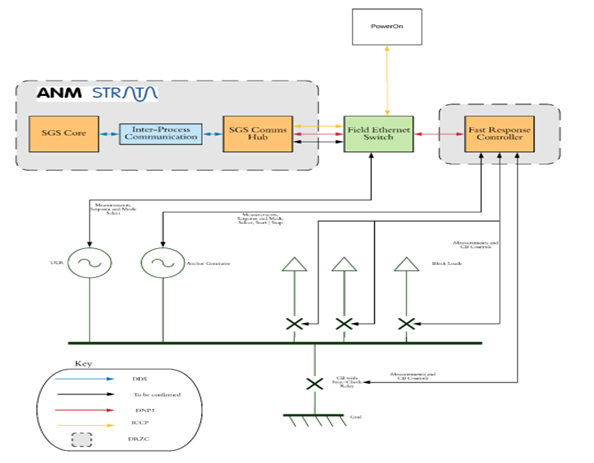Microgrid applications – Resilience including Black Starting (Part 5)
This blog series is working through a number of microgrid applications with categories that include:
- Grid, Microgrids, Nano grids and VPPs - what’s all that about? (Part 1)
- Remote or off grid systems (Part 2)
- Grid connection capacity management and market access benefits (Part 3)
- Supply security improvement (Part 4)
- Resilience applications including black start applications (Part 5)
- Driving low carbon initiatives (Part 6)
- Observations on the drivers to deploy microgrids (Part 7)
Whereas blog 4 in this series focussed on customer side microgrid applications to improve supply security above that provided by the utility company grid supply, this blog focuses on utility company microgrid applications to improve the resilience of their grid supplies to customers. This is similar to customer side applications in that there is a desire to transition to a distribution energy resource (DER) based, microgrid controlled island, manage stability in the island condition and resynchronise the island with the main grid network when conditions allow. However, the utility microgrid island networks typically cover much larger geographic areas than with customer side microgrids. This raises the focus on a number of concerns that although applicable to customer side microgrid islands, often require an increased focus due to the industry codes and policies that public utility companies operate under. These concerns include:
- the impacts on protection systems designed for intact network (grid connected) operations rather than island network conditions e.g. the ability of protection devices to detect and operate to clear short circuits with much reduced fault levels;
- the increased rate of change of frequency (RoCoF) due to lower system inertia in the microgrid island network, which can result in supporting DER on the distribution network island being disconnected through their loss of mains protection (often RoCoF protection) leading to electrical island instability;
- the need to establish the correct system earthing arrangements on transitioning from a grid to island condition and back,
- the availability of suitable communications with DER,
- transformer inrush issues during island black start supply restoration,
- Block load supply restoration during island black starting is more difficult to predict and requires fast acting frequency and voltage regulation.
During my time with Smarter Grid Solutions (SGS) I have worked on several microgrid projects including one for a UK utility distribution network operator (DNO) looking to provide supply resilience to poorly served customers in remote locations, and another for the UK ESO (Electricity System Operator) looking to support the national network black start strategy using distribution network DER based islands.
- SSEN’s Resilience as a Service (RaaS) project is trialling the use of battery energy storage systems (BESS) and other supporting DER provided by a third party RaaS provider. The project has had to address the issues listed above. SGS has specified a control system for the DNO side that monitors the performance of the third party RaaS systems, acts where required and alerts the DNO control room and third party RaaS provider, allowing the DNO control room to enable/disable a number of processes, e.g. island to grid resynchronisation and controlling the island black start supply restoration sequence when required. The third party RaaS BESS control system ensures stable frequency and voltage regulation at all times during RaaS service provision. SSEN are planning a 2-year demonstration and trial operation of a RaaS scheme at SSEN’s Drynoch 33/11kV primary substation on the Isle of Skye in Scotland.
- National Grid ESO’s Distributed ReStart is a world-first initiative. The project explores how all forms of DER, synchronous and converter connected, scheduled and intermittent including solar, wind, hydro, energy from waste, CHP, energy storage, etc. can be used to restore power to the GB transmission network in the unlikely event of a blackout - a process known as Black Start. SGS along with a number of other companies provided designs for the key microgrid element referred to as the Distribution Restart Zone Controller (DRZC). SGS’s DRZC design supports the automation of the process of black starting the DRZ island network; provides fast balancing of voltage and frequency for block load pickup supported by BESS or load banks where required; provides slower balancing of demand and generation to maintain the DRZ voltage and frequency; and provides suitable synchronising back to a reinstated transmission network or to other black started DRZs.

Information on both featured projects is available in the public domain.
SGS has also supported the Lawrence Livermore National Lab with the CleanStart DERMS project. This is another DER based national black start strategy initiative, this time funded by the Department of Energy (DoE) in the US. SGS used its experience with DER management control systems to provide control system design support to the CleanStart DERMS project which, similar to the UK ESO Distributed Restart project, utilises the concept of microgrid islands for Black Start services.
SGS has supported other DNO resilience projects including Northern Power Grid’s Micro-Resilience innovation project which is based on low voltage (LV) utility network microgrids. SGS is delivering its Strata Resilience product to coordinate diverse LV DERs (generators, controllable load, energy storage devices) in a microgrid environment. SGS’s Strata Resilience software provides microgrid coordination and control of DER (including energy storage as an anchor supply), facilitating use cases such as grid-connected support (power factor control), planned/un-planned islanding transition, island-to-grid transition (re-synchronisation) and islanded operation. The solution is being deployed at four LV network areas that suffer from high outage probability or contain vulnerable/critical customers. The project is currently entering the network demonstration phase at the time of writing this blog.
SGS’s Strata Resilience product is a software-based microgrid manager that delivers grid connected, island and black start operations while optimizing the value of microgrid assets for customers with grid and market integration. Strata Resilience delivers the core capabilities of DER microgrid management.


Leave a Comment